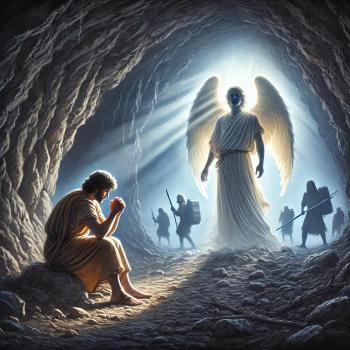Revelation 10:1-11 God’s Intermission of the Tribulation
Yesterday, my family and I went to Silver Dollar City. We arrived at 10am and did not leave until after 7:30pm that evening. We rode many rides, ate food along the and ended the day with a show at Echo Hollow Theatre. It started at 6:00pm with a pre-show. Then they had the main show which they called “Hits From the Hollow.” A male vocal group “The Harmonics” and the female vocal group “The Heartbeats” took turns singing songs from the 1960s and the 1980s. The master of ceremonies dismissed the groups for an intermission show – “The All-Star Stunt Dogs.” We had a break and then the dogs came on stage to perform tricks. During this intermission, the groups took a break backstage and prepared for the last half of the performance.
In Revelation 10:1-11, we have God giving an intermission during the Tribulation. Soon we will be introduced to seven key figures who play a role during the Tribulation period. But right now, we have an intermission. God is still active, but it is as if God is preparing His people for what is to come. I like to think of this interval as a pause before the continuing activity of the second half of the book.
Between the sixth and the seventh seal judgments is an interlude that features two visions: the 144,000 in 7:1–8 and the great multitude in 7:9–17. Similarly, between the sixth and the seventh trumpet judgments we find an interlude consisting of two visions: the mighty angel and the little scroll in 10:1–11, when John is recommissioned to prophesy, and the vision of the two witnesses in 11:1–13, when the role and destiny of the witnessing church is described. (Interestingly, there is no parallel interlude between the sixth and the seventh bowl judgments.) As with the other interludes in Revelation, 10:1–11:13 clarifies the role of God’s people and offers perspective and encouragement to help them endure faithfully1
THE MIGHTY ANGEL (Revelation 10:1)
“Then I saw another mighty angel coming down from heaven, surrounded by a cloud, with a rainbow over his head. His face was like the sun, his legs were like fiery pillars,” (Revelation 10:1, HCSB)
This being could well be our Lord Jesus Christ, appearing to John as a kingly angel. Jesus often appeared in the Old Testament as “the Angel of the Lord”. This was a temporary manifestation for a special purpose, not a permanent incarnation.2
Three “strong angels” appear in Revelation (5:2; 10:1; 18:21), and the first two are both associated with the scroll of God’s redemptive plan.3
“I also saw a mighty angel proclaiming in a loud voice, “Who is worthy to open the scroll and break its seals?”” (Revelation 5:2, HCSB)
“Then a mighty angel picked up a stone like a large millstone and threw it into the sea, saying: In this way, Babylon the great city will be thrown down violently and never be found again.” (Revelation 18:21, HCSB)
THE LITTLE SCROLL (Revelation 10:2)
“and he had a little scroll opened in his hand. He put his right foot on the sea, his left on the land,” (Revelation 10:2, HCSB)
Commentators debate whether the “scroll” of Revelation 5 is the same as the “little scroll” of Revelation 10. While there are variations between the two scrolls (e.g., scroll vs. little scroll, sealed vs. open, heavenly scene vs. earthly scene), the similarities suggest that a single scroll is in view: both are held by a mighty angel, both draw on Ezekiel’s prophetic calling (see Ezekiel 2:9–3:3), and both concern God’s redemptive plan.4 Wilson suggests that perhaps the designation “little scroll” says more about the large size of the mighty angel than the small size of the book.4 In chapter 5 the scroll was sealed with seven seals, which were then opened by the Lamb in Revelation 6. Now in chapter 10 the scroll lies open in the angel’s hand. The scroll reveals how God plans to defeat evil, rescue his people, and transform his creation, and what all this means for John and the rest of God’s people on earth.5
THE SEVEN THUNDERS (Revelation 10:3-4)
“and he cried out with a loud voice like a roaring lion. When he cried out, the seven thunders spoke with their voices. And when the seven thunders spoke, I was about to write. Then I heard a voice from heaven, saying, “Seal up what the seven thunders said, and do not write it down!”” (Revelation 10:3–4, HCSB)
The seven thunders are in response to the cry of the mighty angel. In this case, the thunders are just as loud as the angel. What fascinates me about these thunder judgments is that we don’t know what they are. We are told the seal and trumpet judgments before the thunder judgments. We are told the events of the Tribulation period and the people involved, and we are told the bowl judgments. But there is part of this period which John was told, but which God did not let him reveal.
This reminds me of Paul and the vision God gave him in 2 Corinthians 12. In that chapter, Paul recalls an event in his life in which God showed him amazing things, which could not be understood on Earth. Yet God would not let Paul reveal them to other people. The reason was to keep Paul humble, to preserve part of the mystery.
Paige Patterson says:
Here once again possibly God is acting to reveal through his apostle much but not all of what he is intending to do in terms of the judgments of the tribulation period. That some of those judgments remain recondite as far as the reader is concerned is a literary device functioning as an ominous threat, having the effect of saying, “You have seen a great deal, but nowhere close to all of my hand in judgment.”6
I tend to agree. We don’t know everything that God will do. God preserving part of prophecy as a mystery even to us. But then God goes on to show us something else.
However, it may be a reference to the glory of God. In Psalm 29, God’s voice is compared to the power of thunder.
- The voice above the waters (29:3)
-
The voice of power (29:4)
-
The voice in splendor (29:4)
-
The voice shatters (29:5)
-
The voice flashes flames (29:7)
-
The voice shakes the wilderness (29:8)
-
The voice strips nature bare (29:9)
This the seven-fold thundering voice of God. These thunders are similar to the seven thunders in Revelation. In Revelation, they are not revealed although they happen between the trumpet and the bowl judgments. The effects of the thunders are not described in Revelation. However, I suspect the seven thunders in Revelation refer to the same seven thunders from Psalm 29.7
THE OATH AND ANNOUNCEMENT (Revelation 10:5-7)
“Then the angel that I had seen standing on the sea and on the land raised his right hand to heaven. He swore an oath by the One who lives forever and ever, who created heaven and what is in it, the earth and what is in it, and the sea and what is in it: “There will no longer be an interval of time, but in the days of the sound of the seventh angel, when he will blow his trumpet, then God’s hidden plan will be completed, as He announced to His servants the prophets.”” (Revelation 10:5–7, HCSB)
The Greek word translated “time” is chronos and means either “time” or “delay.” Delay is what is meant here. “Thy kingdom come,” we pray. “But where are You, Lord?”
“I’m on the way, but I have chosen to delay,” He says.
Why? I believe Peter gives us the reason: The Lord is not slack concerning His promise, but is longsuffering, not willing that any should perish, but that all should come to repentance (2 Peter 3:9).
Truly, the Lord is longsuffering, waiting for people to receive Him, to hear the Good News, to be part of the kingdom. But there’s coming a time when there will be no more delay.8
JOHN EATS THE SCROLL (Revelation 10:8-10)
“Now the voice that I heard from heaven spoke to me again and said, “Go, take the scroll that lies open in the hand of the angel who is standing on the sea and on the land.” So I went to the angel and asked him to give me the little scroll. He said to me, “Take and eat it; it will be bitter in your stomach, but it will be as sweet as honey in your mouth.” Then I took the little scroll from the angel’s hand and ate it. It was as sweet as honey in my mouth, but when I ate it, my stomach became bitter.” (Revelation 10:8–10, HCSB)
The message of judgment and the message of hope have always been united together in the prophetic teaching of the Old and New Testaments. Jeremiah sees a vast boiling cauldron which is an omen of judgment; yet within the same vision Jeremiah sees an almond branch which is the sign of hope in the midst of winter (Jeremiah 1). The stern John the Baptist proclaims a bitter message that is also profoundly sweet. He challenges sin and he points to the Savior.
It was Luther who described our Christian message as “the message of Law and Gospel.” “In fact, we cannot hear the last word until we have heard the next to the last word” (Bonhoeffer). Even in the message of forgiveness is the implication of guilt and judgment. What is important to note is that John is commissioned to tell the whole world the twofold message, the whole truth—it is bitter and sweet.9
The scene here in Revelation is similar to another event in the life of Ezekiel. Ezekiel was told to eat a scroll before he could continue his mission. It was only after Ezekiel ate the book that was sweet to his mouth but bitter to his belly that he was able to share boldly with those of whom he had previously been afraid.
““Son of man,” He said to me, “eat and fill your stomach with this scroll I am giving you.” So I ate it, and it was as sweet as honey in my mouth.” (Ezekiel 3:3, HCSB)
“So the Spirit lifted me up and took me away. I left in bitterness and in an angry spirit, and the Lord’s hand was on me powerfully.” (Ezekiel 3:14, HCSB)
The bitterness in his belly motivated Ezekiel to share truth.10
THE COMMISSION (Revelation 10:11)
“And I was told, “You must prophesy again about many peoples, nations, languages, and kings.”” (Revelation 10:11, HCSB)
At the intermission of the show at Silver Dollar City, the announcer encouraged everyone to get a snack. He spoke of a new funnel cake that they were selling – a S’Mores funnel cake, made with chocolate, marshmallows, and Graham cracker sprinkles. The point was get something to eat to help us through the second act. During this intermission, John is told to eat a scroll. It wasn’t the same as a S’Mores funnel cake. Yet it served the same purpose. The scroll provided what John needed so that he could continue to prophesy. God could continue to use John to reveal what God was going to do during the Tribulation period.
1 J. Scott Duvall, Revelation, ed. Mark L. Strauss and John H. Walton, Teach the Text Commentary Series (Grand Rapids, MI: Baker Books, 2014), 142.
2 Warren W. Wiersbe, The Bible Exposition Commentary, vol. 2 (Wheaton, IL: Victor Books, 1996), 597. For Scriptures referring to the “angel of the Lord,” see: (Exodus 3:2; Judges 2:4; 6:11–12, 21–22; 2 Samuel 24:16)
3 J. Scott Duvall, Revelation, ed. Mark L. Strauss and John H. Walton, Teach the Text Commentary Series (Grand Rapids, MI: Baker Books, 2014), 142.
43 The term “little scroll,” or biblaridion, is the diminutive of biblarion, which is the diminutive of biblion, meaning “scroll” or “book.” Yet even the “little scroll” is simply labeled “the scroll” in 10:8 (to biblion).
4 Wilson, “Revelation,” 308–9.
5 J. Scott Duvall, Revelation, ed. Mark L. Strauss and John H. Walton, Teach the Text Commentary Series (Grand Rapids, MI: Baker Books, 2014), 143.
6 Paige Patterson, Revelation, ed. E. Ray Clendenen, vol. 39, The New American Commentary (Nashville, TN: B&H, 2012), 231.
8 Jon Courson, Jon Courson’s Application Commentary (Nashville, TN: Thomas Nelson, 2003), 1721.
9 Earl F. Palmer and Lloyd J. Ogilvie, 1, 2 & 3 John / Revelation, vol. 35, The Preacher’s Commentary Series (Nashville, TN: Thomas Nelson Inc, 1982), 183.
10 Jon Courson, Jon Courson’s Application Commentary (Nashville, TN: Thomas Nelson, 2003), 1721.















